What's the Best Reusable Water Bottle?
Find out how to choose the best reusable water bottle, plus how to clean your water bottle and where to refill.
There are plenty of good reasons why many universities and communities have enacted bans on single-use plastic water bottles, following in the footsteps of Concord, Massachusetts, which in January 2013 became the first town in the U.S. to ban the sale of single-use plastic water bottles. By switching to a tap-filled reusable water bottle, you'll drink water just as pure and help reduce the global glut of plastic bottles.
-Gretel H. Schueller, Contributing Writer

Is Bottled Water Better Than Tap Water?
In fact, a four-year-long review by the National Resources Defense Council, which included independent testing of more than 1,000 bottles of water, concluded that bottled water is not necessarily cleaner or safer than regular tap water. What's more, federal regulation of tap water is more stringent than that of bottled water. The review also noted that at least 25 percent of bottled water is just tap water. If you're concerned about what comes out of your tap or hate the chlorine taste, install an under-sink or faucet-mounted water filter certified by NSF International.
Your wallet will thank you for choosing a reusable container too: Americans spent $10.6 billion on bottled water in 2009-paying up to 1,000 times the cost of tap water, according to the nonprofit Food and Water Watch.
That's news we can all drink to. Read on to get the lowdown on which reusable water bottle is the best choice for you.
Glass
Glass water bottles are recyclable and easiest to clean. Though glass is also the most fragile, most versions come with a silicone sleeve to protect them from breaking.
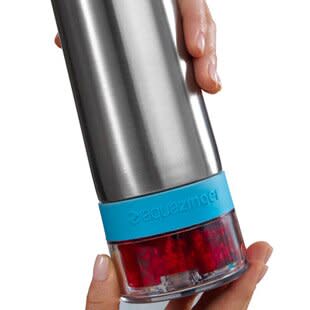
Stainless Steel
Stainless steel is lightweight and generally dishwasher-safe. It can dent when dropped. There is also a new brand of stainless-steel bottles aiming to make drinking water more exciting and delicious. The Aqua Zinger, for example, is a stainless-steel water bottle with a built-in grinder cup. Infuser bottles like this let you infuse your water with a variety of fruit, veggies or herbs. The flavor is light-not as heavy as juice or as plain as water. Try watermelon with basil, or cucumber and mint.
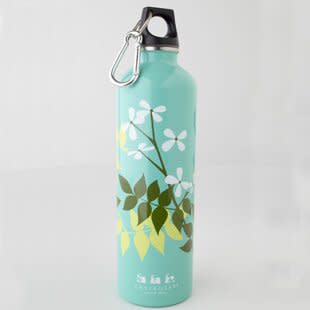
Aluminum
Aluminum bottles often look like stainless steel but have a big difference. Because aluminum reacts with acidic liquids, they are lined with an enamel or epoxy layer that can wear down. They are not dishwasher-safe. And some linings contain as much BPA as their plastic predecessors, according to a University of Cincinnati College of Medicine study. You can get a good gauge of whether the lining will leach BPA by looking at the color: a golden-orange coating will; a white coating will not. (The new linings by Sigg do not.)
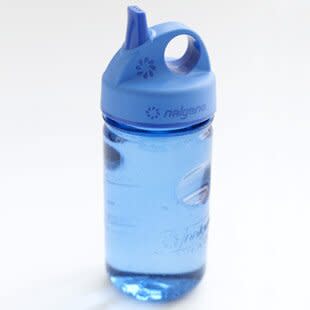
Plastic
Plastic bottles are typically less expensive than other options. And since 2010, most are BPA-free. They are not safe for hot liquids or microwaves and health concerns with other leachable toxins in plastic still exist. Also, keep in mind that the term BPA-free has no real meaning: no regulation limits what product can make that claim.
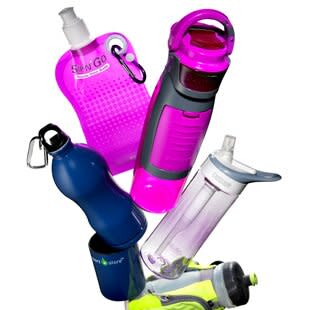
How to Clean Your Reusable Water Bottle
Water bottles provide an ideal home for mold and bacteria, which thrive in moist environments. Plastic is more prone to bacterial growth because it can crack and get scratched-those nicks provide perfect nooks for bacteria to take root. Some bottles are dishwasher-safe, but even a dishwasher can't reach the insides of a built-in straw or the far depths of a narrow-mouthed bottle. A bottlebrush helps to scrub some of those recesses. Wide-mouth bottles are easier to clean. The Square, by Clean Bottle, offers astainless-steeldesign that unscrewsfrom bothends for full cleaning access. Fizzy cleaning tablets, such as Bottle Bright by Clean Ethics, can clean hard-to-reach spots. Air-dry both the cap and bottle completely to prevent bacterial growth.
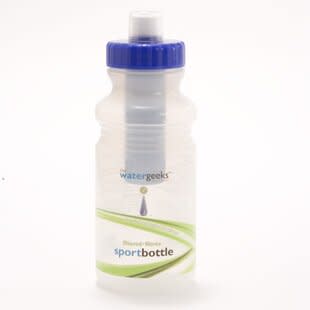
Reusable Water Bottle Refill Options
Refilling your reusable bottle when you're out of the house can be challenging. But it's getting easier. Brita offers a BPA-free plastic water bottle with a built-in filter. According to Brita, one filter can replace 300 disposable plastic bottles. The real future may lie in so-called hydration stations that are appearing on campuses, at airports, highway rest stops, parks, office buildings and even band tours-from the Black Eyed Peas to Dave Matthews. Powered by tap water, these modern-day water fountains are specially designed to let you fill your bottle-with no more weird angling or failure to fill to the top. Technology is also helping. New York City, for example, recently launched "Water-on-the-Go," a phone app to help you locate water stations throughout the five boroughs. The "TapIt" phone app offers a network of eateries across the country where you can refill your bottle with tap water for free.